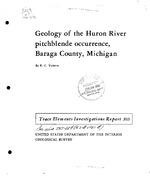Small quantities of uranium-bearing minerals were discovered by a geologist of the Jones and Laughlin Ore Company during the summer of 1949 along the East Branch of the Huron River, sec. 1, T. 51 N., R. 30 W., Baraga County, Mich. Subsequent diamond drilling of the prospect by the Jones and Laughlin Ore Company and the Ford Motor Company disclosed only minor amounts of radioactive materials at shallow depths in the immediate vicinity of the surface showings.
Pitchblende and secondary uranium minerals occur as very small, discontinuous stringers and pods in calcite and quartz cementing the breccia within a low-angle shear zone that dips about 10 degrees to the southwest. The shear zone has a thickness of 10 to 30 feet and cuts black, locally carbonaceous slates of the upper Huronian Precambrian Michigamme slate. Mineral deposition during two hypogene stages and one supergene stage was identified in polished sections. The first phase consisted of the introduction of quartz and minor hematite into the sheared slate. After fracturing of the quartz the second stage was initiated by deposition of calcite, pyrite, rutile, pitchblende, bornite, sphalerite, chalcopyrite, galena, and greenockite. The supergene stage consisted of the development of metatyuyamunite, chalcopyrite, chalcocite, covellite, cuprite, volborthite, malachite, and goethite.


